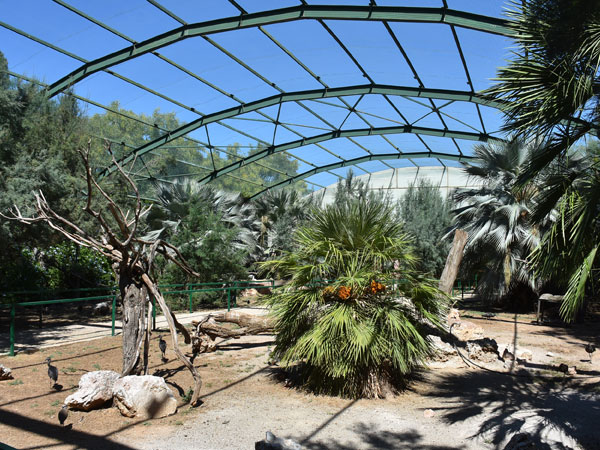General info
Name of Zoo: ATTIKA ZOOLOGICAL PARK
Name of respondent: ANNA KAZAZOU
E-mail address of respondent: anna@atticapark.gr
Name of Exhibit: Africa/America/Asia
Opening Date/Year: 01/05/00/
Dimensions
Height in m: 9m
Area in m2: 1200m²
Volume in m3: 60mx20mx9m
Shape
Shape sides: rectangular
Shape of top: domed
Construction
Frame
1) placement main support structures: arched (one side to other)
2) materials main support: other (specify)
3) special supports/protection for:
(a) interface net/mesh and main support: galvanied steel colones
(b) protection from main supports rotting in ground: N.A.
4) secondary supporting structures: N.A.
Material sides
1) solid (rock, brick wood etc): 1
2) glass: N.A.
3) piano wire: N.A.
4) netting/mesh: 3
a) material: Plastified galvanied structure
b) name manufacturer: N.A.
c) supplier: N.A.
d) product name: N.A.
e) opening size: 2.5
f) diameter: 2,5×2,5
g) color: dark green
h) configuration:
i) how is netting/meshing attached to aviary structure? scrued on cleton and cliped beetween
j) visibility through net/mesh: excellent
k) water resistance: satisfactory
l) UV resistance: satisfactory
Material top
1) Same as sides: no
a) name manufacturer: N.A.
b) name product: N.A.
c) material: galvanized wire (galvanized after welding)
d) configuration: woven
e) opening size: N.A.
f) diameter: N.A.
g) color : N.A.
h) water resistance: satisfactory
i) UV resistance: satisfactory
Visitor viewing
Walk through / walk in: yes
Barriers between public and birds: rails
Other special features to enhance viewing possibilities: N.A.
Entrances and exits
Service:
i. double doors with area between: yes
ii. through attached building:
iii: please describe how you bring in large enclosure furnishings that are too large to be brought through the doors:
Visitor: “curtains” as second door – chains
Curtains: N.A.
Water area
% surface area water (versus land): 20%
Frequency of drainage and cleaning: ones per week
Type of water: still
Filtration system: no
Depth in cm:
i. minimum: 20
ii. maximum: 50
iii. % surface area < 20 cm: N.A.
Substrates
Sand: 30%
Grass: 10%
Dirt: 30%
Rocks: 20%
Visitor path: 10%
Other: N.A.
Vegetation
Grass/other herbacious plants < 20 cm high cover: 40%
Herbacious plants/shrubs 20 cm- 1m high cover: 30%
Herbacious plants/shrubs/trees 1 m-3 m high cover: 15%
Number of coniferous trees > 3 m high: none
Number of deciduous trees > 3 m high: 5
Are there any plants you would recommend for aviariesMorus alba
Are there any plants that have been problematic in this aviary?: N.A.
Predator protection
Electric fence inside: N.A.
Electric fence outside: N.A.
Different type meshing along bottom: N.A.
Plastic along perimeter: N.A.
Concrete under ground: yes 50
Other (specify): N.A.
Suplemental lightning
Supplemental lighting outside: no
Permanent introduction/catching area present
Introduction and/or catching area present: yes
Indoor enclosure
Attached to aviary: N.A.
Dimensions:
i. length: 9
ii. width: 20
iii. Height: 9
Average number of nights used per year: open all year around to protect from summer heat or wind
Average number of days used per year: all year
Direct access to main outside enclosure: yes
Direct access to alternative outdoor area: yes
Substrates (specify):
Usable water area present for bathing: yes
Possibility to subdivide area if need to: yes
Keeper access area not shared by birds: no
Natural sunlight received: yes
Number of hours of artifical light: none
Heating supplied: no
Species
Species currently held (if possible also historically) list: Africa- glossy ibis, crested pigeon, red crested turaco, golden becked weaver, african grey hornbill, hammerkop, America – scarlet ibis, black faced ibis,spoonbill, white cheeked pintail, american wood duck, baikal teal, Asia – Red whiskered bulbul, Creasted pigeon, Nutmeg pigeon, Mandarian duck, Green winged dove, crane,eurasia spoonbill
Species not held successfully: N.A.
Reason per species (please list species below)
i. escape: N.A.
ii. incompatibility: N.A.
iii. health issues: N.A.
iv. stress: N.A.
v. accidents (e.g. collisions): N.A.
vi. other: N.A.
Problems
Problems with:
Indigenous bird species entering enclosure: yes, specify sparrows
Predation in enclosures: yes, specify rats
Aviary withstanding winds experienced: no
Aviary withstanding snow experienced: no
Excessive mortality and or accidents with one or more species: no
Other health issues, e.g. foot lesions: no
Frequent replacement or repair of materials: yes, specify the top cover polycarbonate sheet needs to be replaced due to strong winds and heat.
Husbandry issues e.g. cleaning, heating, moving birds:
Dissatisfaction
Visitor: no
Keeper: no
Cost
Design: zero
Materials and labor: 50.000euro per aviary
Maintenance (e.g. replacement of netting etc.): 500 euro
Were there any choices made/possibilities to reduce costs? no

